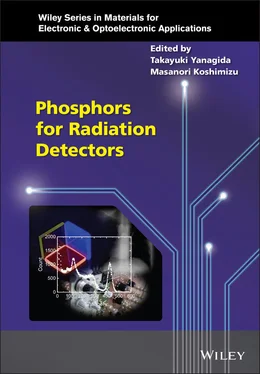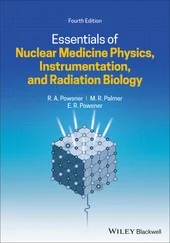Phosphors for Radiation Detectors
Здесь есть возможность читать онлайн «Phosphors for Radiation Detectors» — ознакомительный отрывок электронной книги совершенно бесплатно, а после прочтения отрывка купить полную версию. В некоторых случаях можно слушать аудио, скачать через торрент в формате fb2 и присутствует краткое содержание. Жанр: unrecognised, на английском языке. Описание произведения, (предисловие) а так же отзывы посетителей доступны на портале библиотеки ЛибКат.
- Название:Phosphors for Radiation Detectors
- Автор:
- Жанр:
- Год:неизвестен
- ISBN:нет данных
- Рейтинг книги:3 / 5. Голосов: 1
-
Избранное:Добавить в избранное
- Отзывы:
-
Ваша оценка:
- 60
- 1
- 2
- 3
- 4
- 5
Phosphors for Radiation Detectors: краткое содержание, описание и аннотация
Предлагаем к чтению аннотацию, описание, краткое содержание или предисловие (зависит от того, что написал сам автор книги «Phosphors for Radiation Detectors»). Если вы не нашли необходимую информацию о книге — напишите в комментариях, мы постараемся отыскать её.
Phosphors for Radiation Detectors
Discover a comprehensive overview of luminescence phosphors for radiation detection Phosphors for Radiation Detection,
Phosphors for Radiation Detection
Phosphors for Radiation Detection
Phosphors for Radiation Detectors — читать онлайн ознакомительный отрывок
Ниже представлен текст книги, разбитый по страницам. Система сохранения места последней прочитанной страницы, позволяет с удобством читать онлайн бесплатно книгу «Phosphors for Radiation Detectors», без необходимости каждый раз заново искать на чём Вы остановились. Поставьте закладку, и сможете в любой момент перейти на страницу, на которой закончили чтение.
Интервал:
Закладка:
Table of Contents
1 Cover
2 Series Page
3 Title Page
4 Copyright Page
5 List of Contributors
6 Preface
7 Series Preface
8 1 Ionizing Radiation Induced Luminescence 1.1 Introduction 1.2 Interactions of Ionizing Radiation with Matter 1.3 Scintillation 1.4 Ionizing Radiation Induced Storage Luminescence 1.5 Relationship of Scintillation and Storage Luminescence 1.6 Common Characterization Techniques of Ionizing Radiation Induced Luminescence Properties References
9 2 Organic Scintillators 2.1 Introduction 2.2 Basic Electronic Processes in Organic Scintillators 2.3 Liquid Scintillators 2.4 Organic Crystalline Scintillators 2.5 Plastic Scintillators 2.6 Organic–Inorganic Hybrid Scintillators References
10 3 Inorganic Oxide Scintillators 3.1 Introduction 3.2 Crystal Growth 3.3 Outlines of Oxide Scintillators 3.4 Silicate Materials 3.5 Garnet Materials 3.6 Perovskite Materials 3.7 Materials with Intrinsic Luminescence References
11 4 Inorganic Fluoride Scintillators 4.1 Introduction 4.2 Crystal Growth of Fluorides 4.3 Outline of Fluoride Scintillators 4.4 Fluoride Scintillators for γ‐Ray Detection 4.5 Fluoride Scintillators for Neutron Detection 4.6 Fluoride Scintillators for Charged Particle Detection References
12 5 Inorganic Halide Scintillators 5.1 Introduction: History of Inorganic Halide Scintillator Research and Development 5.2 Characteristics of Halide Materials 5.3 Basic Techniques for Halide Scintillation Crystal Growth 5.4 Novel Ternary and Quaternary Halide Scintillators 5.5 Mixed‐Anion Halide Scintillators 5.6 Next Generation of Halide Scintillators References
13 6 Semiconductor Scintillators 6.1 Introduction 6.2 Photoluminescence and Scintillation Mechanisms in Semiconductors 6.3 Various Semiconductor Scintillators 6.4 Quantum Size Effect 6.5 Organic–Inorganic Perovskite‐Type Compounds References
14 7 Thermally Stimulated Luminescent (TSL) Materials 7.1 Introduction 7.2 TSL Phenomenon 7.3 TSL Materials: Fluoride, Oxides, Sulfates, and Borate 7.4 TSL Dosimetric Properties for Photons, Charged Particles, and Neutrons 7.5 Two‐Dimensional (2‐D) TSL Dosimetry References
15 8 Optically‐Stimulated Luminescent Dosimeters 8.1 Introduction 8.2 Principles of OSL Phenomenon 8.3 OSL Materials and Dosimeters 8.4 Applications of OSL 8.5 Future Perspective References
16 9 Radiophotoluminescence (RPL) 9.1 Introduction 9.2 RPL Phenomenon and the Definition 9.3 RPL Materials and Applications 9.4 Conclusions References
17 10 New Materials for Radiation Detectors 10.1 Introduction of Transparent Ceramic Materials 10.2 Preparation Methodology 10.3 Transparent Materials 10.4 Transparent Ceramic Scintillator 10.5 Transparent Ceramics for Dosimeter References
18 11 Luminescence in Glass‐Based Materials by Ionizing Radiation 11.1 Introduction 11.2 Structural and Physical Properties of Glass 11.3 Attenuation of Quantum Beam as Shielding Materials 11.4 Defect Formation in Oxide Glass by Quantum Beam Irradiation 11.5 Scintillation in Oxide Glass 11.6 Scintillation and Dosimetry in Non‐oxide Glass 11.7 Preparation of Glass 11.8 Future Prospectives for Glass‐Based Materials Acknowledgement References
19 12 Detectors Using Radiation Induced Luminescence 12.1 Introduction 12.2 General Issues to Manufacturing the Detector 12.3 Scintillation Detectors for Gamma‐Rays and X‐Rays 12.4 Scintillation Detectors for Charged Particles 12.5 Scintillation Detectors for Neutrons 12.6 Personal Dosimeters 12.7 OSL‐Based Imaging System References
20 Index
21 End User License Agreement
List of Tables
1 Chapter 2 Table 2.1 Scintillation properties of commercially available liquid organic scint... Table 2.2 Scintillation properties of organic crystals. Table 2.3 Scintillation properties of commercially available plastic scintillator...
2 Chapter 3Table 3.1 Usable temperature ( T max) and atmosphere of various crucibles for ...Table 3.2 Oxide scintillators with intrinsic luminescence. Table 3.3 Ce‐doped oxide scintillators. Table 3.4 Other rare‐earth‐doped oxide scintillators.
3 Chapter 4Table 4.1 Fluoride scintillators based on luminescence from 5d‐4f transitions of ...Table 4.2 Fluoride scintillators based on core‐valence luminescence. Table 4.3 Fluoride scintillators based on luminescence from 5d‐4f transitions of ...Table 4.4 Fluoride scintillators for thermal neutron detection. Table 4.5 Properties of the LiCAF:Eu, Na single crystal, the LiF/CaF2:Eu eutectic...
4 Chapter 5Table 5.1 Discovered and developed Ce3+‐activated alkali‐halide‐rare‐earth halide...Table 5.2 Scintillation light yield and energy resolution of K2LaX5:Ce (X = Cl, B...Table 5.3 Discovered and developed Eu2+‐activated alkali‐halide‐alkalin‐earth hal...Table 5.4 Summary of scintillation properties for LaBr2.25I0.75:Ce, LaBr1I2:Ce, L...Table 5.5 Discovered and developed Hf‐ and Tl‐based halide scintillators. ...Table 5.6 Properties of Tl2LiYCl6:Ce compared with commercially available Cs2LiYC...
5 Chapter 6Table 6.1 Scintillation characteristics of various semiconductor scintillators. ...Table 6.2 Exciton energy ( E ex), bandgap energy ( E g), oscillator strength ( f e...Table 6.3 Exciton peak and crystal structure in the inorganic layer. Distortion o...Table 6.4 Physical properties of excitons and crystal structure in the inorganic ...Table 6.5 Scintillation properties of organic–inorganic layered perovskite‐type c...
6 Chapter 7Table 7.1 Measured wavelengths and line widths of the main spectral lines for CaF...Table 7.2 Measured wavelengths and line widths of the main spectral lines for CaF...Table 7.3 Properties of the main TSL dosimeter (TSLD) elements most commonly used...Table 7.4 LET dependence of alumina‐based ceramic [74]. Table 7.5 Comparisons of characteristics of each type of 2‐D TSLD.
7 Chapter 8Table 8.1 List of OSL materials. Table 8.2 Application fields of passive‐type dosimeters using OPL and RPL phenome...Table 8.3 OSL properties to be considered for dosimetric application. Table 8.4 Comparison of OSL properties.
8 Chapter 9Table 9.1 List of example RPL materials.
9 Chapter 10Table 10.1 Example of transparent ceramics and their applications. Table 10.2 Common characteristics of single crystal, glass, and ceramic.
10 Chapter 11Table 11.1 Representative defects in SiO2 glasses [64]. Table 11.2 Typical ns2‐type emission centers reported in oxide glass system. ...Table 11.3 A selection of glasses for X‐ray glass scintillators. Table 11.4 A selection of glasses for scintillator applications [136–143]. * mean...Table 11.5 Chemical composition of Ag‐doped phosphate glasses for RPL application...Table 11.6 Maximum phonon energy of typical glasses and crystals. Table 11.7 Composition and properties of typical fluoride glasses [182].
11 Chapter 12Table 12.1 Properties of 6Li‐based scintillators [23]
List of Illustrations
1 Chapter 1 Figure 1.1 Classification of solid state ionizing radiation detectors. Figure 1.2 Interaction of typical ionizing radiations with matter. Figure 1.3 Typical emission mechanisms of scintillation. Figure 1.4 Typical emission mechanisms of scintillation. Figure 1.5 Emission spectra of scintillators under X‐ray irradiation and typ ... Figure 1.6 (Top) Relationship between the scintillation decay time (ns) and ... Figure 1.7 Relationship between the scintillation decay time (ns) and emissi ... Figure 1.8 Emission mechanisms of TSL, OSL, and RPL. Figure 1.9 Typical emission mechanisms of scintillation, OSL, TSL, and RPL. ... Figure 1.10 The inverse proportional relationship of Ce differently doped Ca ... Figure 1.11 Schematic drawing of transmittance (absorption) (a) and PL measu ... Figure 1.12 Schematic drawing of PL decay setup. Figure 1.13 Common setup of X‐ray induced radioluminescence spectrum measure ... Figure 1.14 Common setup of γ‐ray induced scintillation decay curve measurem ...
Читать дальшеИнтервал:
Закладка:
Похожие книги на «Phosphors for Radiation Detectors»
Представляем Вашему вниманию похожие книги на «Phosphors for Radiation Detectors» списком для выбора. Мы отобрали схожую по названию и смыслу литературу в надежде предоставить читателям больше вариантов отыскать новые, интересные, ещё непрочитанные произведения.
Обсуждение, отзывы о книге «Phosphors for Radiation Detectors» и просто собственные мнения читателей. Оставьте ваши комментарии, напишите, что Вы думаете о произведении, его смысле или главных героях. Укажите что конкретно понравилось, а что нет, и почему Вы так считаете.












